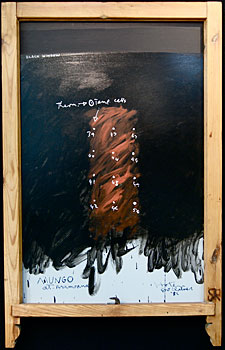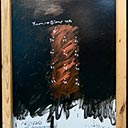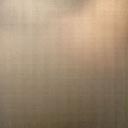Black Window - Mungo at Aramoana
103.5 x 66 cm
Provenance: Purchased by current owner from Brooke Gifford Gallery, Christchurch, 1982
Towards Aramoana label affixed verso
What hint do the words "black" and "window" give us as to the meaning of Hotere's work? We stand motionless in front of a window, we look through the window and we behold a scene. The scene is confined by the frame; the scene stretches from the glass, in the front, through the vast space behind and on to a vanishing point on the horizon. We stand motionless in front of a painting; we look at the painting and we behold a scene. The scene is confined by the frame; the scene stretches from picture plane (the imaginary glass) through the "space", the picture space, and on to a vanishing point on the painted horizon. This is a simplified version of Brunelleschi's and Alberti's take on perspective, commonly known as the Renaissance window. Hotere has taken the frame of an old villa's sash window to reinforce the idea in our mind of a view to behold in New Zealand. Hotere's Black Paintings originated as a protest in the early 1980s against the proposed aluminum smelter at Aramoana. Destruction of the natural beauty of the area and the toxic waste it would produce were the issues of concern. Imagine looking out of a window at night: the view is black, the death of that day. Hotere has extended that simple image: given the area, he is implying a future death of the environment indicated by black acrylic paint with silver/ grey of the smelter. Black painted board replaces the glass of a demolition sash window complete with brass handle just as an ugly smelter cancels out the view of an idyllic New Zealand scene.
This work is part of the Mungo series where the significance of black to the artist is reinforced with the words BLACK WINDOW in upper case at the top left. In the Mungo National Park a very important archaeological discovery was made in 1974 - human remains dating up to 68,000 years ago. At this site, a weathering experiment was set up to determine the deterioration of materials such as wood, bone and shell buried in the different layers of soil and every few years the results would be quantified. (Kriselle Baker).
Above the words BLACK WINDOW stretches out two layers in different tones of a hazy grey seemingly above or beyond a shore with indications of light and sun. But Hotere, as is his wont, does not leave the viewer completely devoid of hope. The bed of Lake Mungo, dry as it was, revealed the length of man's existence, which it otherwise could not have done. Perhaps, too, some good will come eventually from the construction of the smelter. Hotere paints a swirling mass of red gold, the greatest symbol in sacred terms and the most important metal in economic and secular terms, on which is written in four groups of three in white the temperatures of the samples. The four Gospels added to our knowledge of the tri-partite Christian God; 4 x 3 = spiritual knowledge, and the results of these samples will also add to Man's knowledge not only in Mungo but in Aramoana as well. The length of Man's existence in Mungo becomes, in this Hotere work, an existential reflection on the quality of life in Aramoana: Black Window - Mungo at Aramoana.
Angela Mackie





